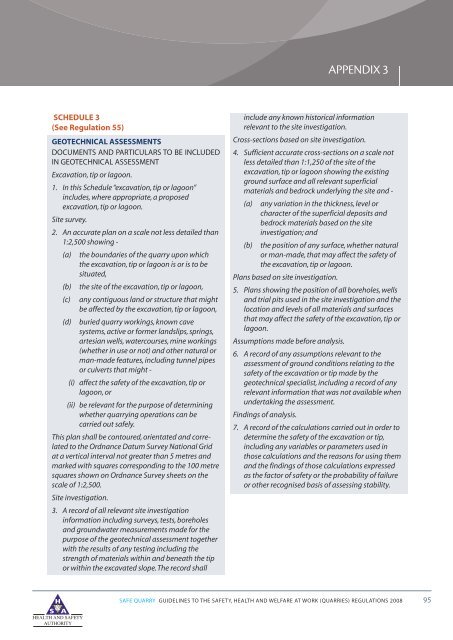Safe Quarry - Health and Safety Authority
Safe Quarry - Health and Safety Authority
Safe Quarry - Health and Safety Authority
Create successful ePaper yourself
Turn your PDF publications into a flip-book with our unique Google optimized e-Paper software.
APPENDIX 3<br />
SCHEDULE 3<br />
(See Regulation 55)<br />
GEOTECHNICAL ASSESSMENTS<br />
DOCUMENTS AND PARTICULARS TO BE INCLUDED<br />
IN GEOTECHNICAL ASSESSMENT<br />
Excavation, tip or lagoon.<br />
1. In this Schedule “excavation, tip or lagoon”<br />
includes, where appropriate, a proposed<br />
excavation, tip or lagoon.<br />
Site survey.<br />
2. An accurate plan on a scale not less detailed than<br />
1:2,500 showing -<br />
(a) the boundaries of the quarry upon which<br />
the excavation, tip or lagoon is or is to be<br />
situated,<br />
(b) the site of the excavation, tip or lagoon,<br />
(c) any contiguous l<strong>and</strong> or structure that might<br />
be affected by the excavation, tip or lagoon,<br />
(d) buried quarry workings, known cave<br />
systems, active or former l<strong>and</strong>slips, springs,<br />
artesian wells, watercourses, mine workings<br />
(whether in use or not) <strong>and</strong> other natural or<br />
man-made features, including tunnel pipes<br />
or culverts that might -<br />
(i) affect the safety of the excavation, tip or<br />
lagoon, or<br />
(ii) be relevant for the purpose of determining<br />
whether quarrying operations can be<br />
carried out safely.<br />
This plan shall be contoured, orientated <strong>and</strong> correlated<br />
to the Ordnance Datum Survey National Grid<br />
at a vertical interval not greater than 5 metres <strong>and</strong><br />
marked with squares corresponding to the 100 metre<br />
squares shown on Ordnance Survey sheets on the<br />
scale of 1:2,500.<br />
Site investigation.<br />
3. A record of all relevant site investigation<br />
information including surveys, tests, boreholes<br />
<strong>and</strong> groundwater measurements made for the<br />
purpose of the geotechnical assessment together<br />
with the results of any testing including the<br />
strength of materials within <strong>and</strong> beneath the tip<br />
or within the excavated slope.The record shall<br />
include any known historical information<br />
relevant to the site investigation.<br />
Cross-sections based on site investigation.<br />
4. Sufficient accurate cross-sections on a scale not<br />
less detailed than 1:1,250 of the site of the<br />
excavation, tip or lagoon showing the existing<br />
ground surface <strong>and</strong> all relevant superficial<br />
materials <strong>and</strong> bedrock underlying the site <strong>and</strong> -<br />
(a) any variation in the thickness, level or<br />
character of the superficial deposits <strong>and</strong><br />
bedrock materials based on the site<br />
investigation; <strong>and</strong><br />
(b) the position of any surface, whether natural<br />
or man-made, that may affect the safety of<br />
the excavation, tip or lagoon.<br />
Plans based on site investigation.<br />
5. Plans showing the position of all boreholes, wells<br />
<strong>and</strong> trial pits used in the site investigation <strong>and</strong> the<br />
location <strong>and</strong> levels of all materials <strong>and</strong> surfaces<br />
that may affect the safety of the excavation, tip or<br />
lagoon.<br />
Assumptions made before analysis.<br />
6. A record of any assumptions relevant to the<br />
assessment of ground conditions relating to the<br />
safety of the excavation or tip made by the<br />
geotechnical specialist, including a record of any<br />
relevant information that was not available when<br />
undertaking the assessment.<br />
Findings of analysis.<br />
7. A record of the calculations carried out in order to<br />
determine the safety of the excavation or tip,<br />
including any variables or parameters used in<br />
those calculations <strong>and</strong> the reasons for using them<br />
<strong>and</strong> the findings of those calculations expressed<br />
as the factor of safety or the probability of failure<br />
or other recognised basis of assessing stability.<br />
SAFE QUARRY GUIDELINES TO THE SAFETY, HEALTH AND WELFARE AT WORK (QUARRIES) REGULATIONS 2008 95
















